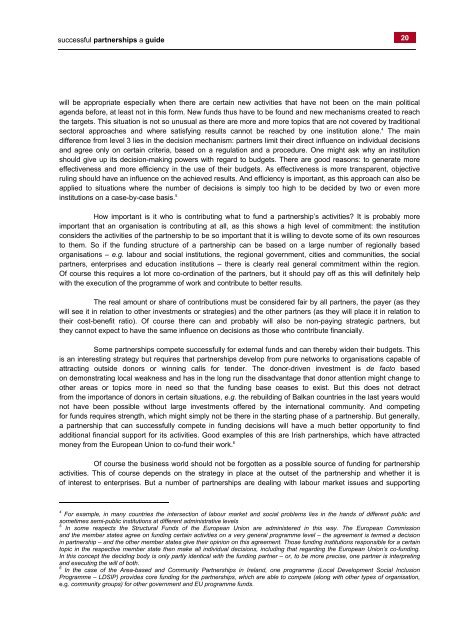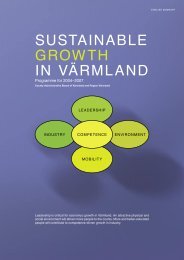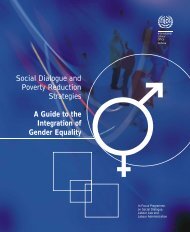successful partnerships a guide - Organisation for Economic Co ...
successful partnerships a guide - Organisation for Economic Co ...
successful partnerships a guide - Organisation for Economic Co ...
Create successful ePaper yourself
Turn your PDF publications into a flip-book with our unique Google optimized e-Paper software.
<strong>successful</strong> <strong>partnerships</strong> a <strong>guide</strong><br />
20<br />
will be appropriate especially when there are certain new activities that have not been on the main political<br />
agenda be<strong>for</strong>e, at least not in this <strong>for</strong>m. New funds thus have to be found and new mechanisms created to reach<br />
the targets. This situation is not so unusual as there are more and more topics that are not covered by traditional<br />
sectoral approaches and where satisfying results cannot be reached by one institution alone. 4 The main<br />
difference from level 3 lies in the decision mechanism: partners limit their direct influence on individual decisions<br />
and agree only on certain criteria, based on a regulation and a procedure. One might ask why an institution<br />
should give up its decision-making powers with regard to budgets. There are good reasons: to generate more<br />
effectiveness and more efficiency in the use of their budgets. As effectiveness is more transparent, objective<br />
ruling should have an influence on the achieved results. And efficiency is important, as this approach can also be<br />
applied to situations where the number of decisions is simply too high to be decided by two or even more<br />
institutions on a case-by-case basis. 5<br />
How important is it who is contributing what to fund a partnership’s activities It is probably more<br />
important that an organisation is contributing at all, as this shows a high level of commitment: the institution<br />
considers the activities of the partnership to be so important that it is willing to devote some of its own resources<br />
to them. So if the funding structure of a partnership can be based on a large number of regionally based<br />
organisations – e.g. labour and social institutions, the regional government, cities and communities, the social<br />
partners, enterprises and education institutions – there is clearly real general commitment within the region.<br />
Of course this requires a lot more co-ordination of the partners, but it should pay off as this will definitely help<br />
with the execution of the programme of work and contribute to better results.<br />
The real amount or share of contributions must be considered fair by all partners, the payer (as they<br />
will see it in relation to other investments or strategies) and the other partners (as they will place it in relation to<br />
their cost-benefit ratio). Of course there can and probably will also be non-paying strategic partners, but<br />
they cannot expect to have the same influence on decisions as those who contribute financially.<br />
Some <strong>partnerships</strong> compete <strong>successful</strong>ly <strong>for</strong> external funds and can thereby widen their budgets. This<br />
is an interesting strategy but requires that <strong>partnerships</strong> develop from pure networks to organisations capable of<br />
attracting outside donors or winning calls <strong>for</strong> tender. The donor-driven investment is de facto based<br />
on demonstrating local weakness and has in the long run the disadvantage that donor attention might change to<br />
other areas or topics more in need so that the funding base ceases to exist. But this does not detract<br />
from the importance of donors in certain situations, e.g. the rebuilding of Balkan countries in the last years would<br />
not have been possible without large investments offered by the international community. And competing<br />
<strong>for</strong> funds requires strength, which might simply not be there in the starting phase of a partnership. But generally,<br />
a partnership that can <strong>successful</strong>ly compete in funding decisions will have a much better opportunity to find<br />
additional financial support <strong>for</strong> its activities. Good examples of this are Irish <strong>partnerships</strong>, which have attracted<br />
money from the European Union to co-fund their work. 6<br />
Of course the business world should not be <strong>for</strong>gotten as a possible source of funding <strong>for</strong> partnership<br />
activities. This of course depends on the strategy in place at the outset of the partnership and whether it is<br />
of interest to enterprises. But a number of <strong>partnerships</strong> are dealing with labour market issues and supporting<br />
4 For example, in many countries the intersection of labour market and social problems lies in the hands of different public and<br />
sometimes semi-public institutions at different administrative levels<br />
5 In some respects the Structural Funds of the European Union are administered in this way. The European <strong>Co</strong>mmission<br />
and the member states agree on funding certain activities on a very general programme level – the agreement is termed a decision<br />
in partnership – and the other member states give their opinion on this agreement. Those funding institutions responsible <strong>for</strong> a certain<br />
topic in the respective member state then make all individual decisions, including that regarding the European Union’s co-funding.<br />
In this concept the deciding body is only partly identical with the funding partner – or, to be more precise, one partner is interpreting<br />
and executing the will of both.<br />
6 In the case of the Area-based and <strong>Co</strong>mmunity Partnerships in Ireland, one programme (Local Development Social Inclusion<br />
Programme – LDSIP) provides core funding <strong>for</strong> the <strong>partnerships</strong>, which are able to compete (along with other types of organisation,<br />
e.g. community groups) <strong>for</strong> other government and EU programme funds.








